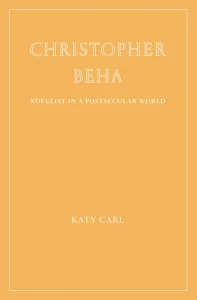
Wiseblood Books, which leans in the direction of being a Catholic publisher, has been issuing a series of novels and poetry collections that that interesting, thought-provoking, and broader than the idea of “Catholic publisher” might imply. Its novelists and poets include Dana Gioia, Marly Youmans, James Matthew Wilson, Samuel Hazo, Charles Hughes, Katy Carl, Sally Thomas, Glenn Arbery, R.R. Reno, and others.
What these writers have in common is that they write perceptively and unapologetically about faith, although it’s usually not that obvious. The fiction is serious, literary fiction; the poetry is just as serious, and just as literary. Both compare favorably to anything produced by mainstream, “secular” publishers. Wiseblood’s books aren’t out to score political points and tick the boxes of the latest social and cultural mania to seize the imaginations of what passes for America’s literary elites.
Instead, they tell stories. They wrestle with what people wrestle with, including holding on to faith in a world growing more indifferent and more hostile.

I was reminded of this when I read a Wiseblood monograph, Christopher Beha: Novelist in a Postsecular World by Katy Carl. I’ve heard of Beha, a writer and novelist who served as editor of Harper’s Magazine from 2019 to 2023. He stepped down from the position for the best of reasons; he couldn’t balance his editorial duties with his writing.
Carl’s 32-page monograph explores Beha’s novels – The Whole Five Feet (2010), What Happened to Sophie Wilder(2012), Arts & Entertainments (2014), and The Index of Self-Destructive Acts (2020). And what she finds is that, in what describes as a “postsecular” world, raising the possibility of faith and belief is, well, okay. You can do it in serious fiction, and Beha does it very well, indeed.
Carl is the editor in chief of Dappled Things Magazine. Her stories and articles have appeared in numerous literary publications, and she previously published the novel As Earth Without Water (2021) and a short story collection, Fragile Objects (2023). She was chosen as Wiseblood Books first writer in residence in 2020, and she is pursuing an MFA degree in creative writing at the University of St. Thomas in Houston., whose founding faculty were James Matthew Wilson and Joshua Hren.

Her essay on Beha’s novels repeatedly made me think about my own writing, and how I would describe it. I don’t write literary fiction. I can’t say I write “popular” fiction, or mass market fiction, either. When asked, I’ve said “contemporary fiction.” A few people have suggested “alternative history” or even “alternative future history.” More recently, it’s been historical fiction – no doubts about what to call a novel set during the Civil War and 1915. And now a new one is underway, and it’s definitely contemporary fiction.
It may be a copout of sorts, but, setting labels aside, all authors have to write the story that’s asking to be written, because it’s a story that the author has to tell.
I’ve gradually learned the importance of trusting my characters and writing like the writer Harvey Stanbrough describes – WITD, or “writing into the dark.” That means writing with no set outline but trusting your characters enough because they know what they’re doing. I learned that lesson with my last novel, Dancing Prince. One character refused to stay in the minor role I planned for him. I finally surrendered and gave him his head, and he took over.
And it worked.
Related:
Fragile Objects: Short Stories by Katy Carl.
Top photograph by Aman Upadhyay via Unsplash. Used with permission.











